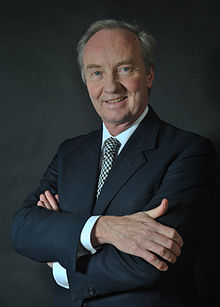Duke of Buccleuch
Duke of Buccleuch [ bəˈkluː ] is a hereditary British title in the Peerage of Scotland .
The title is named after the hamlet of Buccleuch near Selkirk , Scottish Borders .
The respective Duke is the hereditary Clan Chief of Clan Scott .
Award of the title
The title was on 20 April 1663 for James Scott, 1st Duke of Monmouth , an illegitimate son of King Charles II. Created the Anne Scott, 4th Countess of Buccleuch , had married.
On the same day, she was also appointed duchess in her own right. As a result, the title did not expire when Monmouth was executed for high treason after the failure of the Monmouth Rebellion for reaching for the royal crown after the death of his father in 1685. Such awards of titles of nobility to women were rare in Scotland, unlike England and Ireland, but not uncommon.
The Scott family is thus one of the " bastard lines " of the royal house of Stuart , as are the families FitzRoy ( dukes of Grafton ), Beauclerk ( dukes of St. Albans ) and Lennox ( dukes of Richmond and Gordon ), who were also descended from the illegitimate sons of Charles II ) as well as the Catholic Fitz-James (dukes of Berwick, dukes of Alba, etc.) who were descended from the brother of Charles II.
Other titles
In 1810 the 3rd Duke inherited the title of Duke of Queensberry , also in the Peerage of Scotland, while the title of Marquess of Queensberry passed to another relative. Since then, the duke has been one of only five men in the United Kingdom to hold two or more dukedoms.
Subordinate title
The secondary titles of the Dukedom are: Earl of Buccleuch (created 1619), Earl of Dalkeith (created 1663), Lord Scott of Buccleuch (created 1606) and Lord Scott of Whitchester and Eskdaill (created 1619), all in the Peerage of Scotland.
The Duke also has two subordinate titles to the Duke of Monmouth , namely Earl of Doncaster (created 1663) and Baron Scott of Tindale (created 1663), both in the Peerage of England . These were initially confiscated after the high treason of the Duke of Monmouth, but were transferred back to the second Duke in 1742.
Finally, the title of Duke of Queensberry includes the subordinate titles Marquess of Dumfriesshire (created 1683), Earl of Drumlanrig and Sanquhar (created 1682), Viscount of Nith, Tortholwald and Ross (created 1682) and Lord Douglas of Kilmount, Middlebie and Dornock ( created 1682), all in the Peerage of Scotland.
The eldest son of the respective duke uses the courtesy title Earl of Dalkeith , the eldest son that of Lord Eskdaill .
capital
The current Duke of Buccleuch is the largest private land owner in the United Kingdom. His assets of approximately £ 450 million are largely concentrated in the Buccleuch Group , which is primarily active in the real estate, agriculture, food and beverage sectors. His land holdings are estimated at around 110,000 hectares.
The family's country estates are Bowhill House , near Selkirk , which is the ancestral home of the Scott family; Drumlanrig Castle in Dumfries and Galloway , which was an ancestral home of the Douglas family ; and Boughton House in Northamptonshire , England , ancestral home of the Montague family. These three castles are still inhabited by the family today, but some can also be visited. Dalkeith House in Midlothian , also an old Douglas residence, has also been owned by the Scott family since 1642 but is rented out. In the past the family has owned various other manors, chateaux and castles, including the Montagu Houses in Bloomsbury and Whitehall as London residences .
List of title holders
Lords Scott of Buccleuch (1606)
- Walter Scott, 1st Lord Scott of Buccleuch (1565-1611)
- Walter Scott, 2nd Lord Scott of Buccleuch († 1633) (was elevated to Earl of Buccleuch in 1619 )
Earl of Buccleuch (1619)
- Walter Scott, 1st Earl of Buccleuch († 1633)
- Francis Scott, 2nd Earl of Buccleuch (1626–1651)
- Mary Scott, 3rd Countess of Buccleuch (1647–1661)
- Anne Scott, 4th Countess of Buccleuch (1651–1732) (was raised to Duchess of Buccleuch in 1663 )
Duke of Buccleuch, first award (1663)
- James Scott, 1st Duke of Monmouth, 1st Duke of Buccleuch (1649–1685) (withdrawn)
Duke of Buccleuch, second award (1663)
- Anne Scott, 1st Duchess of Buccleuch (1651-1732)
- Francis Scott, 2nd Duke of Buccleuch (1695–1751)
- Henry Scott, 3rd Duke of Buccleuch , 5th Duke of Queensberry (1746–1812)
- Charles Montagu-Scott, 4th Duke of Buccleuch , 6th Duke of Queensberry (1772–1819)
- Walter Montagu-Douglas-Scott, 5th Duke of Buccleuch , 7th Duke of Queensberry (1806-1884)
- William Montagu-Douglas-Scott, 6th Duke of Buccleuch , 8th Duke of Queensberry (1831-1914)
- John Montagu-Douglas-Scott, 7th Duke of Buccleuch , 9th Duke of Queensberry (1864–1935)
- Walter Montagu-Douglas-Scott, 8th Duke of Buccleuch , 10th Duke of Queensberry (1894–1973)
- John Scott, 9th Duke of Buccleuch , 11th Duke of Queensberry (1923-2007)
- Richard Scott, 10th Duke of Buccleuch , 12th Duke of Queensberry (* 1954)
The heir ( Heir Apparent ) of the Dukes is his son, Walter Scott, Earl of Dalkeith (* 1984).
Others
- Sir Walter Scott, Bt. Is a direct descendant of the Lords of Buccleuch. His famous poem The Lay of the Last Minstrel deals with family history.
- Alice, Duchess of Gloucester , was a daughter of the 7th Duke of Buccleuch. She married Prince Henry, 1st Duke of Gloucester , third son of King George V in 1935 .
Literature and web links
- Charles Kidd, David Williamson (Eds.): Debrett's Peerage and Baronetage . St Martin's Press, New York 1990.
- Leigh Rayment's Peerage Page
- Buccleuch Group website








